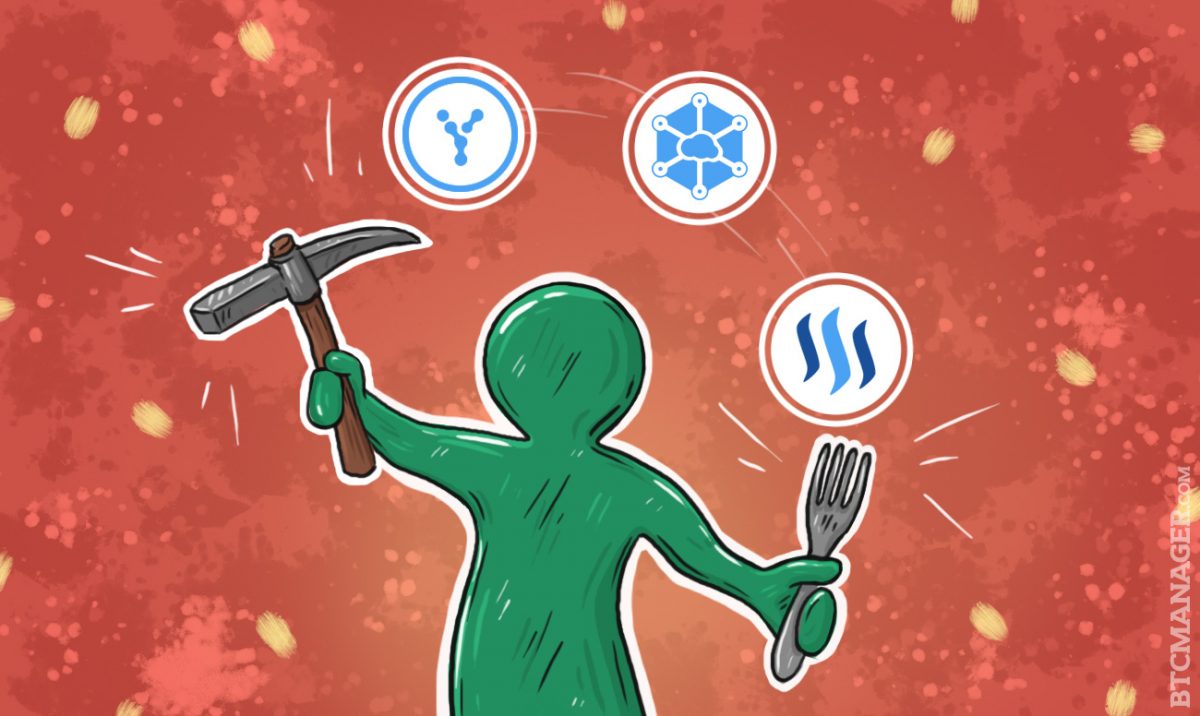Blockchain and the Rise of the “Prosumer”

Blockchain technology will decentralize many industries and allow for a wider array of economic opportunities for individuals. By removing power from entrenched, centralized corporations and organizations, this technology is giving birth to ‘prosumers’ in several areas. This term was coined by Alvin Toffler in 1980 as someone who blurs the distinction between being a consumer and a producer.
Several novel projects are aimed at using the blockchain to bring change to centralized systems to enhance the consumer and producer experience. Many of us are already ‘prosumers’ of social media; but we don’t yet receive anything for our posts or finding good quality posts with low exposure. Moreover, we are also seeing interesting applications in energy and data storage enabling the rise of ‘prosumers’.
Social Media: The Phenomenal Rise of Steemit
Steemit is one example of a new blockchain created from scratch, introducing a gift or sharing economy based on a novel cryptocurrency called STEEM; it has rapidly risen above most other cryptocurrencies in terms market capitalization, becoming the 3rd largest and worth over $2.00 per STEEM at the time of writing.
While traditional social media sites make money from users without giving them a slice, Steemit is a social media site backed by a cryptocurrency that rewards users for original, creative content as well as for voting on and curating quality content. After signing up, users can upvote blogs, videos and so on to generate a payout to the author. By buying-in or earning STEEM, users can increase their voting influence and exposure of their content. The white paper can be found here.
Another novel feature is that half of the payouts paid to users is in the form of STEEM Power which are long term vests in the platform, linked to the value of STEEM. However, STEEM Power can only be withdrawn over a period of two years in 104 payments, limiting the potential selling pressure and incentivizing long-term growth of the network.
Furthermore, Steemit’s blockchain does not rely on transaction fees instead leaving the community to upvote and downvote data stored on the blockchain. This has proved to work so far as accounts that were copying others people’s posts were found rapidly and the community engaged in a cohesive way to downvote the fraudster and reduce their payout to zero.
Yours, an Alternative Based on Bitcoin
However, Ryan X. Charles from Yours believes that it would be optimal to leverage Bitcoin to build a decentralized, social media platform based on a blockchain. Yours, while still under development, is already exciting the crypto-community. Whereas Steemit was designed with full control over the blockchain’s technical properties and was not limited by the boundaries of Bitcoin, Charles believes they have understated the difficulty of scaling to reach a mainstream audience.
The burden of not just building a community and technical platform but also of a new and novel cryptocurrency is very high in Charles’ eyes. Consequently, solutions will come along at a slower rate. Although saying this, Steemit has recently gone into open source mode which may ease this burden somewhat.
By taking advantage of the largest blockchain ecosystem, Yours hopes to work with the largest bitcoin companies and experts, allowing it to address scaling and security problems relatively easier and quicker.
“Like any good scientific theory, the bitcoin theory has not yet been nor can ever be proven but so far has withstood every attack.”
This is Charles’ response regarding the decision to run to on Bitcoin’s blockchain and not on Ethereum’s. He states that the DAO attack that crippled Ethereum recently is an example of what he means. Although he never foresaw it, his principle regarding Bitcoin has served him well in a time when the Ethereum community is under pressure.
Competition is healthy and it will be interesting to see how these new, blockchain-focused social media entities will flourish and develop. Steemit is still in beta testing so the full release it something to definitely watch out. Moreover, Yours is still anticipating a release date and is also worth watching closely. What will be intriguing to see is which approach will be more successful.
Will a blockchain with no transaction fees and designed specifically to meet the needs of the community fare better or will Bitcoin’s Blockchain propel the decentralization of social media?
Social Media Censorship
Increasing censorship on social media highlights the need for a blockchain-based social network; it will allow people to share ideas freely, engage in debate and include everyone. By timestamping posts and with a decentralized network of computing and man power ensuring security, the blockchain provides a solution to the problem of censorship on social media. Blockchain technologies such as those behind Steemit or Bitcoin, ensures that a blog post, video or image are stored permanently.
For example, Wikileaks recently accused Facebook of censorship by covering up links to leaked emails from the internal Democratic National Convention emails. Moreover, Facebook has also been criticized for censoring accounts from the Indian Kashmir region. Finally, Reddit has also encountered problems revolving around censorship recently, specifically in the bitcoin channel, r/Bitcoin.
Decentralizing the Energy Grid
Blockchain technology will also soon transform energy grids, where more power will start to be generated locally. Millions of people can utilise solar panels to replace our current set-up relying on big power plants. One interesting avenue of research revolves around a cryptocurrency called NRGcoin and with the public becoming more disgruntled with utility companies, decentralized energy projects will increase in popularity.
NRGcoin
By using solar panels and forming a network, households will be able to become producers as well as passive consumers of electricity. The blockchain can be used to mediate transactions of energy units through a cooperative, decentralized network.
Mike Mihaylov, based at Vrije Universitiet Brussel, is researching such a system and he sees that households will become ‘prosumers’ buying and selling powers using a cryptocurrency – NRGcoin. If someone generates more than enough power for their consumption, the can release it into the local smart grid. The household will receive a certain amount of NRGcoin in return and this transaction can be accurately verified and safely secured by the blockchain. Alternatively, households can buy power with NRGcoin or sell their earned NRGcoin on a separate exchange to cash out.
The advantages of such a system is that will bring further incentives for people to install solar panels and generate their own energy. As there is a market for their energy and directly convertible to NRGcoin, more people will want to produce energy as they know any excess can be sold off. Secondly, the price is fixed and baked into the underlying protocol of the system. One NRGcoin is proposed to be equal to 1 kilowatt-hour. No one, no government or no corporation, can change this.
After running simulations with real-world data from Belgium and setting up mini demonstration models, Mihaylov is now seeking funding to build a full-scale prototype. However, we are unlikely to see progress onward from the pilot stage for such projects until regulation catches up to these new innovations according to Indigo Advisory.
Brooklyn microgrid empowers consumers
In March 2016, the first ever blockchain managed energy transaction took place in Brooklyn, New York. A resident with a solar energy installation sold some of his excess energy to a neighbour, all paid for and recorded through blockchain. Transactive Grid, the company behind this collaboration, is hoping to develop an app that will allow households to set preferences for their energy distribution; you charge a price to obtain maximum profit or choose to set a lower rate to donate to a low-income neighbourhood.
Many blockchain companies focused on energy are emerging, with most using the Ethereum blockchain because of its smart contract functionality. Indigo Advisory, an energy and utilities consulting firm, highlight six energy blockchain companies to watch out for; LO3 Energy, Grid Singularity, Slock.it, SolarCoin, Bankymoon and Powerpeers.
Data Storage
The iCloud hack almost two years ago exposed the vulnerability of securing data on a centralized server. With a cloud data storage service based on the blockchain, data is stored in fragments across the network. By decentralizing storage, the network is less prone to attacked and avoids potential systemic damage and loss of data. This is another area where the blockchain has useful applications and is witnessing the rise of ‘prosumers’.
Storj
One project that has brought this to life is Storj. The project is currently in beta-testing and aims to improve the security of cloud storage as well as reduce the transaction costs involved with storing data in the cloud.
While Storj allows individuals to purchase safe and secure cloud storage, it also allows users to rent out their unused digital storage space and effectively you become a data storage producer. This project allows anyone to capitalize on their unused hard drive disk space or any old, unused external hard drives. The latest version of Storj can be downloaded here.
In return for your digital storage space, Storj rewards you with Storjcoin X (SJCX), it’s own cryptocurrency, currently trading at $0.12 and has a fixed total supply of 500 million. Storj’s market capitalization is $6,387,197, making SJCX the 27th largest cryptocurrency according to coinmarketcap. Storj is looking to implement a payments channel allowing for instant, streaming payments of SJCX in exchange for digital storage space and plans to beta-test this technology, known as ‘picopayments’, during the the third quarter of 2016.
In summary, the rise of blockchain is empowering individuals and bringing about a new class of ‘prosumers’. Currently we are seeing applications in social media, data storage and energy from projects such as Steemit, Yours, Storj and NRGcoin. How these projects continue to develop will be intriguing to follow, as well as whether other applications providing inclusive economic opportunities will continue to emerge.












